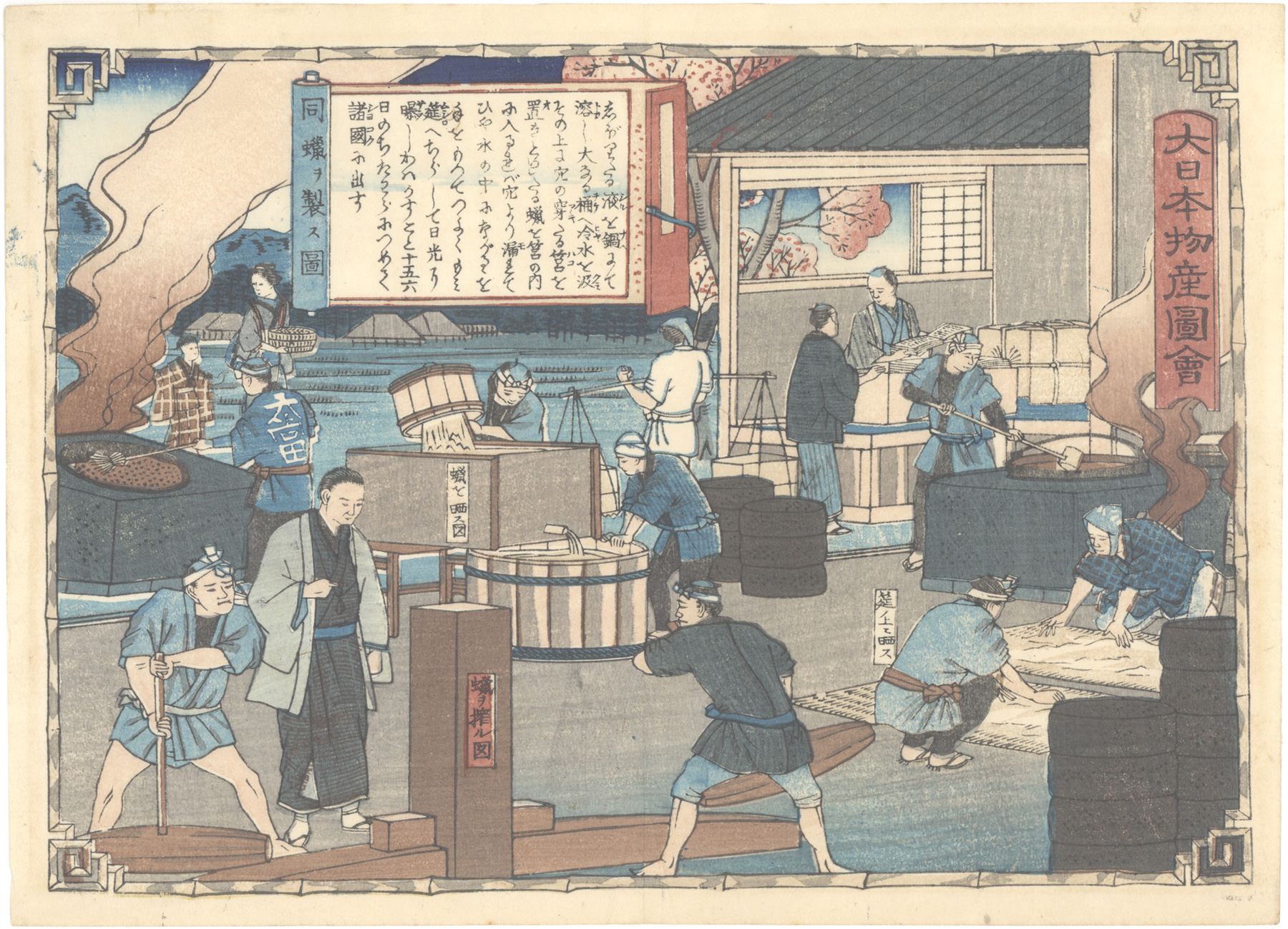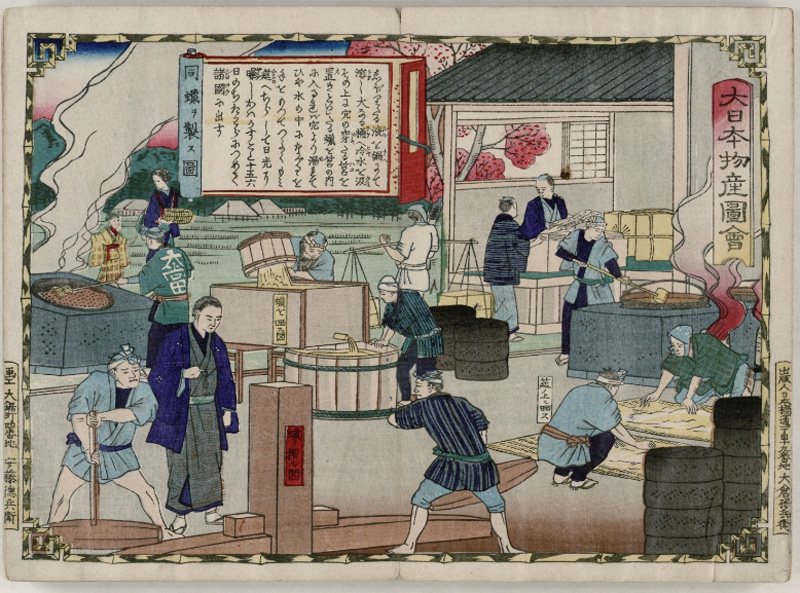About This Print
One of 118 prints in the series Dai Nippon Bussan Zue (Products of Greater Japan), issued in August 1877 to coincide with the opening of Japan’s first National Industrial Exposition (Naikoku Kangyō Hakurankai) held in Tokyo’s Ueno Park. This prints illustrates the steps in producing bleached wax, often called Japan Wax, made from the fruit of the Japanese wax tree (hazenoki).
Refined wax was a significant export to the West, but its value as an export was under pressure from the growing use of kerosene. Considered in the early Meiji era as "one of the chief industries of Japan"1, the process of its creation was detailed in the below 1874 report to London's Asiatic Society of Japan by Henry Gribble, merchant and, later, editor of the Japan Mail.2
last revision:
THE PREPARATION OF VEGETABLE WAX
By Henry Gribble, Esq., of Nagasaki
Read before the Asiatic Society of Japan on the 23rd December 1874
The process of producing wax suitable for export to Europe is atedious one, requiring the outlay of some capital on the part of themanufacturer, who has to keep the berries on hand for at least one year,and, in order to obtain a very superior product, does so frequently forsix or seven years from the time of their being picked and sold by thefarmers.
The berries ripen in October and November, and are picked byhand...
When sufficiently ripe, the berries are thrashed with bamboo flailsand thus separated from their stalks. They are then crushed... They are then wellsteamed over an open kettle, the water in which is kept boiling by awood fire underneath.
From the steaming sieve the mixture is placed “all hot" into thepress bags... and quickly as possible placed in the press... Wedges are driven home by repeated blows of a mallet, and the liquidruns off into its receptacle at the bottom.
After being fully pressed, the “cake" or residue ofthe wax fibre is broken up, again steamed and once more putthrough the press, thus yielding all its available wax.
Meantime the liquid quickly solidifies into a large block of a darkgreen, coarse and tallowy substance, which is at once boiled down andrun off into small earthenware saucers...
In order to purify and bleach the wax for export, it now becomesnecessary to re-boil it in its present stage mixed with water and ashes(either shell or charcoal ashes), and again run it off into large blocks.These blocks are then cut up into thin strips or stored, placed on matsand exposed to the air, during fine clear weather only, for a period offifteen days, and occasionally sprinkled with water. The material isthen again boiled down, mixed with water only this time, and run intolarge blocks. Once more are these blocks cut up into thin strips andagain exposed to the air; this time for a period of about five days.Again boiled down, with no water, the impurities rise to thesurface and are skimmed off, leaving the residue to be run into saucers,assuming the shape and colour of sample No. 4, which is the vegetablewax as known to the European consumer.3
Iwashiro Province (岩代国 Iwashiro no kuni) is an old province in the area of Fukushima Prefecture. It was sometimes called Ganshū (岩州). The province occupies the western half of the central part of Fukushima Prefecture; the eastern half is Iwaki Province. More precisely, Date and Adachi Districts in the north belong to Iwashiro and Higashishirakawa and Nishishirakawa Districts in the south belong to Iwaki. The border between the two provinces is the Abukuma River.5
Multiple Editions (Variant Printings)
At least three variant printings (editions) were made of this series. Each variant printing uses a different colored cartouche, either red, green or rainbow-colored. Different colored borders were also used and variances in the use of colors and shading are present in the three editions.Variant with "rainbow-colored" series cartouche. Also note the yellow
cartouches in the lower left and right margins containing the artist's
name and publisher's name, absent from this collection's print.
Transcription of Scroll
The scroll outlines the steps in refining wax - melt the wax and place it in a box with a hole and let it drip into a large vat filled with cold water. Squeeze the water out and then spread it on a mat. Expose it to sunlight for fifteen or sixteen days. Pack it and then ship it.
Source: website of the Art Research Center, Ritsumeikan University https://www.dh-jac.net/db/nishikie/results-big.php?f1=H-22-1-30-7-19&f11=1&enter=portal
Scroll:
個別解説:「しぼりたる液を鍋にて溶し 大なる桶へ冷水を汲 その上に穴の穿たる筥を置き とかしたる蝋を筥の内に入るれば 穴より漏れてひや水の中にながるゝを 手をもつてつよくもみ 筵へちらして日光に曝しかわかす事十五六日のち たわらにつめて諸国に出す
個別解説:「しぼりたる液を鍋にて溶し 大なる桶へ冷水を汲 その上に穴の穿たる筥を置き とかしたる蝋を筥の内に入るれば 穴より漏れてひや水の中にながるゝを 手をもつてつよくもみ 筵へちらして日光に曝しかわかす事十五六日のち たわらにつめて諸国に出す
1 Transactions of The Asiatic Society of Japan, Vol. III, Part 1, 1875, p. 101
2 website of Bernd Lepach "Meiji Portraits" http://meiji-portraits.de/meiji_portraits_g.html
3 op. cit., Transactions of the Asiatic Society extracted from the full report p. 98-101
Print Details
| IHL Catalog | #2395 |
| Title or Description | Making Wax in Iwashiro Province 同蝋ヲ製ス図 dō (Iwashiro no kuni) rō oseisu zu |
| Series | Dai Nippon Bussan Zue 大日本物産図会 (Products of Greater Japan) |
| Artist | Utagawa Hiroshige III (1842–1894) |
| Signature | not signed Note: the prints in the series are not signed but the artist's family name Andō Tokubei is printed in a cartouche in the lower left margin on some prints |
| Seal | none |
| Publication Date | 1877 (Meiji 10) |
| Publisher | Ōkura Magobei 大倉孫兵衛 (Kin'eido; 1843-1921) [Marks: pub. ref. 627] Note: publisher's information does not appear on this print. |
| Impression | excellent |
| Colors | excellent |
| Condition | good - vertical centerfold and minor marks |
| Genre | nishiki-e; kaika-e |
| Miscellaneous | |
| Format | chuban |
| H x W Paper | 6 15/16 x 9 1/2 in. (17.6 x 24.1 cm) |
| H x W Image | 6 3/8 x 9 in. (16.2 x 22.9 cm) |
| Literature | |
| Collections This Print | Waseda University Library 請求記号 Call No.ヨ01 04265; National Institutes for the Humanities (National Museum of Japanese History) H-22-1-30-7-25; Chiba City Museum |
2/13/2021 - created



